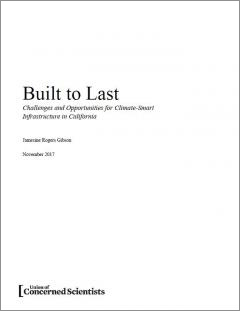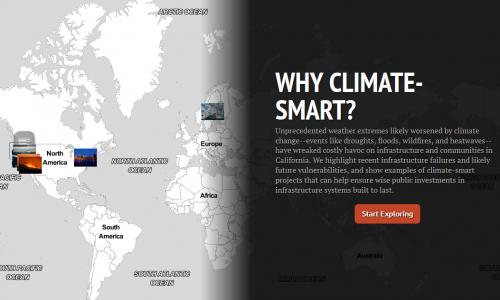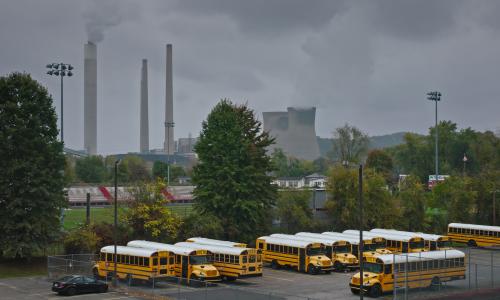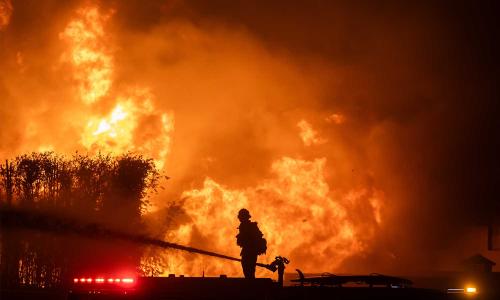California is experiencing more frequent and intense extreme weather events, including this year’s historic floods following a five-year drought, devastating wildfires, and a deadly heat wave. These impacts are expected to worsen as a result of climate change over the coming years. Extreme weather especially impacts California’s aging and deteriorating infrastructure, putting residents and businesses at risk. Increasingly occurring climate extremes add unprecedented pressure to roads, power plants and grids, reservoirs, canals, and other infrastructure unfit to withstand these changes. Recent events, like the Oroville Dam spillway failure or the Wine Country fires, offer a preview of the destruction our vulnerable, under-maintained infrastructure systems will likely face in the future. But, there is a path forward.
Climate-smart infrastructure
We must plan, design, build, retrofit, and maintain California’s infrastructure to withstand the new reality of climate change, if we want to keep Californians safe and protect their livelihoods. Otherwise, we risk building costly infrastructure that may fail well before its intended life span, negatively impacting the well-being, health, and safety of communities, and undermining California's economy and limited recovery resources.
“Climate-smart” infrastructure means designing and building infrastructure with future climate projections in mind, instead of building infrastructure based on past trends. Climate-smart design takes advantage of opportunities to reduce heat-trapping emissions and encourages innovative solutions to bring social, economic, health, and environmental benefits to Californians.
In the next few years, California will invest billions of dollars in new infrastructure, as well as in maintaining and retrofitting existing systems. In this white paper, we outline key principles, barriers, and recommendations to leverage these investments to strengthen the climate resilience of California's infrastructure system, and ensure it will continue to deliver key services for many decades to come.
Principles for climate-smart infrastructure include:
- Applying rigorous science
- Prioritizing equitable outcomes
- Spending limited resources wisely
- Planning proactively, holistically, and transparently
To advance these climate-smart principles in public infrastructure investments and decisions, several barriers and challenges must be overcome. They include: outdated design standards and codes; information that is not readily usable by engineers and other practitioners; limited government capacity and intergovernmental coordination; inadequate funding and underinvestment; insufficient consideration of climate-related costs and resilience benefits; and inadequate analysis of the risks and vulnerabilities faced by low-income communities and communities of color.
Recommendations
Good work is already underway in California and other states to prepare infrastructure for climate impacts, but more must be done by the Golden State to improve and accelerate climate-smart infrastructure decisions. Our recommendations focus on ways the state, as well as local governments, can overcome existing barriers to do just that:
- Update standards and codes.
- Increase local technical capacity.
- Establish a state coordinating center to support state agencies.
- Incorporate costs of climate change and benefits of climate resilience into economic assessments, and develop data and tools for analyses.
- Require meaningful climate-smart criteria for use of public funds.
- Leverage existing and identify new sources of funding and creative financing for climate resilient infrastructure.
- Encourage financial transparency of climate risks for public infrastructure projects.
- Plan in advance for climate-smart disaster recovery efforts.
- Increase local predevelopment capacity, and transparency and inclusion in decision-making.
- Ensure better interjurisdictional and cross-sectoral coordination at both the state and local levels.
By making our existing and new infrastructure climate-smart, we will spend our public funds more wisely, minimize costly and destructive disruptions, protect our communities and the economy from the harm caused by extreme weather and climate stressors, and reduce the disproportionate effects of climate impacts on low-income communities and communities of color, who are more vulnerable to these consequences.
At the same time, climate-smart infrastructure can be designed to reap additional social, economic, health, and environmental benefits. Integrating climate-smart principles into decisions throughout the infrastructure life cycle is critical to ensuring our infrastructure systems are built to last and will deliver needed services to help communities in California thrive now, and in the changing climate future.





